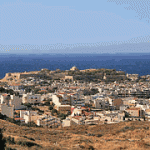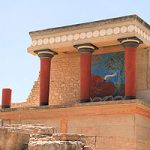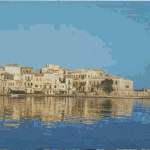The Organizing Committee suggests an entertaining program and the excursions to the participants and accompanying persons. The excursion to Hania (October 17) is included to the organizing fee.
| October 15, Sartuday, 3.00 p.m. | Excursion to Rethymno (34 Euro) |
| October 16, Sunday, 8.30 a.m. | Excursion to Knossos Palace (46 Euro) |
| October 17, Tuesday, 5.00 p.m. | Excursion to Hania (included in the fee package) |
| October 16, Sunday, 7 p.m. | Welcome Reception (included in the fee package) |
| October 19, Wednseday, 7 p.m. | Closing Cocktail (the price will be later) |
 Rethymno is a city of approximately 40,000 people in Greece, the capital of Rethymno peripheral unit in the island of Crete. It was built in antiquity, even though was never a competitive Minoan center. This region as a whole is rich with ancient history, most notably through the Minoan civilisation centred at Kydonia east of Rethymno. Rethymno itself began a period of growth when the Venetian conquerors of the island decided to put an intermediate commercial station between Heraklion and Chania, acquiring its own bishop and nobility in the process. Today’s old town (palia poli) is almost entirely built by the Venetians. It is one of the best preserved old towns in Crete. The town still maintains its old aristocratic appearance, with its buildings dating from the 16th century, arched doorways, stone staircases, Byzantine and Hellenic-Roman remains, the small Venetian harbor and narrow streets. The Venetian Loggia today houses the information office of the Ministry of Culture. The city’s Venetian-era citadel, the Fortezza, is one of the best-preserved castles in Crete. Other monuments include the Neratze mosque (the Municipal Odeon arts centre), the Great Gate (Μεγάλη Πόρτα, Porta Guora), the Piazza Rimondi (Rimondi square) and the Venetian Loggia.
Rethymno is a city of approximately 40,000 people in Greece, the capital of Rethymno peripheral unit in the island of Crete. It was built in antiquity, even though was never a competitive Minoan center. This region as a whole is rich with ancient history, most notably through the Minoan civilisation centred at Kydonia east of Rethymno. Rethymno itself began a period of growth when the Venetian conquerors of the island decided to put an intermediate commercial station between Heraklion and Chania, acquiring its own bishop and nobility in the process. Today’s old town (palia poli) is almost entirely built by the Venetians. It is one of the best preserved old towns in Crete. The town still maintains its old aristocratic appearance, with its buildings dating from the 16th century, arched doorways, stone staircases, Byzantine and Hellenic-Roman remains, the small Venetian harbor and narrow streets. The Venetian Loggia today houses the information office of the Ministry of Culture. The city’s Venetian-era citadel, the Fortezza, is one of the best-preserved castles in Crete. Other monuments include the Neratze mosque (the Municipal Odeon arts centre), the Great Gate (Μεγάλη Πόρτα, Porta Guora), the Piazza Rimondi (Rimondi square) and the Venetian Loggia.
Excursion to Knossos Palace
 This excursion takes you right to the heart of Minoan Crete. The Palace of Knossos , the largest and most imposing of the Minoan civilisation, was discovered at the very end of the nineteenth century by the English archaeologist Sir Arthur Evans. It proved to be an exceedingly beautiful and complex building, leading to the theory that it is at the origin of the myth of the labyrinth and the minotaur. It is thought to have been the seat of the legendary King Minos as well as a major religious centre. The ruins have been partially restored to give you a good impression of what it may have been like in its heyday and the architecture can be seen to be very advanced for its time (it dates from the Bronze Age, around 1700BC), with buildings several storeys high, magnificent staircases and sophisticated natural lighting and drainage systems. Some of the huge pithoi (storage jars) which were found on the site can be seen in situ. Most famous of all are the stunning frescoes, reproductions of which adorn some of the walls. The originals can be seen in the archaeological museum in Heraklion.
This excursion takes you right to the heart of Minoan Crete. The Palace of Knossos , the largest and most imposing of the Minoan civilisation, was discovered at the very end of the nineteenth century by the English archaeologist Sir Arthur Evans. It proved to be an exceedingly beautiful and complex building, leading to the theory that it is at the origin of the myth of the labyrinth and the minotaur. It is thought to have been the seat of the legendary King Minos as well as a major religious centre. The ruins have been partially restored to give you a good impression of what it may have been like in its heyday and the architecture can be seen to be very advanced for its time (it dates from the Bronze Age, around 1700BC), with buildings several storeys high, magnificent staircases and sophisticated natural lighting and drainage systems. Some of the huge pithoi (storage jars) which were found on the site can be seen in situ. Most famous of all are the stunning frescoes, reproductions of which adorn some of the walls. The originals can be seen in the archaeological museum in Heraklion.
The city of Hania
 The city of Hania Built on the ruins of ancient Kidonia, the city of Hania has seen and survived many invaders, but has also tasted civilizations that left their marks on building faces, castles, walls, antiquities, monasteries and churches. The city has two entrances: the airport of Akrotiri, and the port of Souda (the largest in the Mediterranean). The public market holds a master place in the center of the city, a brilliant cross-shaped building that was completed in 1913, and in proportion with the one in Marseilles. Near the city center the Public Garden awaits you next to the “Peace and Friendship of the people” park. The gardens are the prettiest in Crete, and also the public garden offers a small zoo with animals from Cretan fauna. The Venetian port picturesque any time and season is attractive to visitors and locals, for it’s beauty and for it’s choices of entertainment for all tastes and demands. The old city “intramural” districts preserve their Venetian nobility. Narrow paved alleys are surrounded with tasteful renewed houses, from various ages, are offered for a pleasant walk. Chania is the mixing of three architectural styles – the Venetian, Turkish and Greek.
The city of Hania Built on the ruins of ancient Kidonia, the city of Hania has seen and survived many invaders, but has also tasted civilizations that left their marks on building faces, castles, walls, antiquities, monasteries and churches. The city has two entrances: the airport of Akrotiri, and the port of Souda (the largest in the Mediterranean). The public market holds a master place in the center of the city, a brilliant cross-shaped building that was completed in 1913, and in proportion with the one in Marseilles. Near the city center the Public Garden awaits you next to the “Peace and Friendship of the people” park. The gardens are the prettiest in Crete, and also the public garden offers a small zoo with animals from Cretan fauna. The Venetian port picturesque any time and season is attractive to visitors and locals, for it’s beauty and for it’s choices of entertainment for all tastes and demands. The old city “intramural” districts preserve their Venetian nobility. Narrow paved alleys are surrounded with tasteful renewed houses, from various ages, are offered for a pleasant walk. Chania is the mixing of three architectural styles – the Venetian, Turkish and Greek.
POST-CONFERENCE TOUR
 The Organizing Committee invites the
The Organizing Committee invites the
participants to enter 2-days Post-conference tour to SANTORINI. Santorini Greece in the Cyclades, Aegean, has one of the most spectacular landscapes in Greece and in the world. The traditional villages of the island, built on tall cliffs, offer a breathtaking view over the submerged volcano. They represent the beautiful Greek cliche you have always dreamed about! Among them you mustn’t miss Oia, the place gifted with the most famous and stunning sunsets!
The price of the tour is 210 Euro (double accommodation) and
225 Euro (single accommodation).
One breakfast, one lunch and one dinner, and guided excursion are included.
The accommodation is in the tourist-class hotels.
The departure to the post-tour will be held on October 20, 07.30 from the hotels.
Ferry will start at 09.45. The return is scheduled on October 21,
Ferry will start from Santorini at 15.00. Time of returning to Athens is 22.20.
Payment for the Post-tour and additional excursions may be included in the Invoice.
